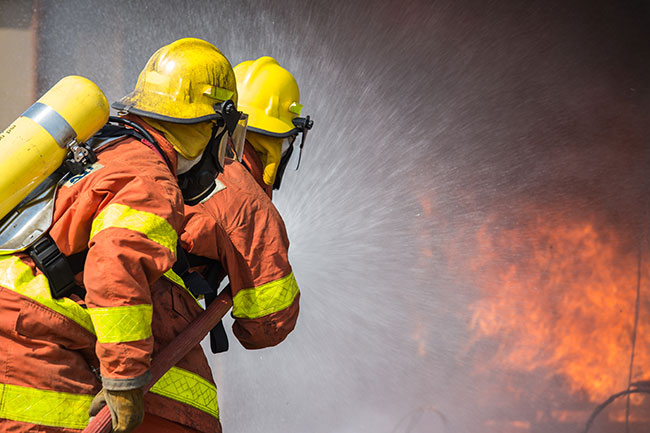
Tools of the trade: Ahead of the Pack
By Sean Kingswell
Features firefighter training SCBA Photo: AdobeStock
Photo: AdobeStock The self-contained breathing apparatus is undoubtedly the most important advancement in firefighting technology. Being able to breathe is essential to allow for aggressive interior fire fighting but, because SCBAs can also wear you down physically, it is important to prepare physically.
SCBAs have improved in many ways over the last 20 years, but the additional components and added air supply have also changed the ergonomics and, in some cases, resulted in heavier loads. In order to counter these issues, it’s best to address fitness elements to ensure the ability to safely wear SCBA for long periods of time and while in compromised positions.
First, of course, we need to understand how it works and how to take it on and off properly. With developments in self-rescue training, we are more prone to donning and doffing the backpack in fire environments than ever before, often in prone or in supine positions. For instance, removing SCBA while standing in good visibility is also entirely different than lying on your side, blinded under a collapse with downed wires.
Adequate shoulder mobility is essential for swimming in and out of the shoulder straps. Rear shoulders can be worked to prevent rounding. As a mirror muscle society, we are predisposed to rounded shoulders from more pushing than pulling in a gym setting. Arm angels are a good exercise for helping with this. For this exercise, simply stand with your back against the wall and slowly slide your arms up and down in a similar movement to a jumping jack, keeping the arms against the wall.
Improving or maintaining good posture will help reduce fatigue while loaded down. Core strength is very important. Isometrically, we need good core strength to stand for long periods of time in our SCBA. Rotating to swing a sledge is also a different experience with an SCBA on as opposed to not. The core is also required when getting into a crawl, not to mention wearing an SCBA in other unnatural positions. While these are only a couple of countless scenarios that challenge the core, we should always aspire to have good functional balance to overcome the displaced load of the SCBA.
Some reaction time training is always prudent in our job, partially because of the risks but also because when those risks occur, we will be inherently hindered by the extra equipment. Improving our reaction time without wearing a SCBA should condition our nervous system to perform better when wearing it.
Having good leg strength helps for numerous reasons. The hips are weight bearing joints and can be conditioned for the extra load. Climbing is, of course, much more difficult and leg strength and endurance makes the act a lot simpler and quicker. Strong ankles and hip adductors can benefit us in fall prevention with the risk of falling always a concern due to unbalanced loads, trip hazards, poor visibility and general fatigue. Ankle work doesn’t typically prevent an ankle from being rolled but it reduces the impact of that roll. Simple band work in multiple directions (one direction at a time for reps) can help to strengthen this tissue. A weight vest in a gym setting can help to simulate an airpack – keep in mind that the load is dispersed differently with the tank of an SCBA being on the back and the straps holding things in place differently. A backpack with weight may be a more realistic scenario.
As I have mentioned over and over, cardio is an important element to our work and being able to wear the pack effectively and stay in the environment long enough are impacted directly by heart health. It also affects our ability to communicate. In most cases, the more winded we are, the worse our masked-up messaging tend to become.
We have looked at the SCBA largely from a fitness perspective but it is important to look at it equally from the health angle. Don’t just wear it on your back, wear it on your face. The carcinogens in our synthetic, high heat environment are well known and effects of these agents is no secret. Fatigue is a common reason why packs come off too early at a fire scene. Being fit enough — and smart enough — to keep SCBAs on allows for a ‘healthy in, healthy out’ mentality and an increased chance at a long and enjoyable retirement.
Sean Kingswell is an experienced professional firefighter, personal trainer, fitness coach and the creator of the FIRESAFECADETS program. Contact Sean at firesafecadets@gmail.com.
Print this page